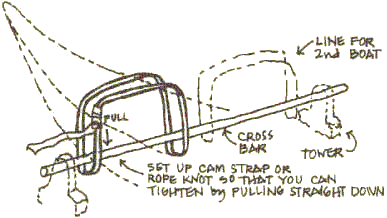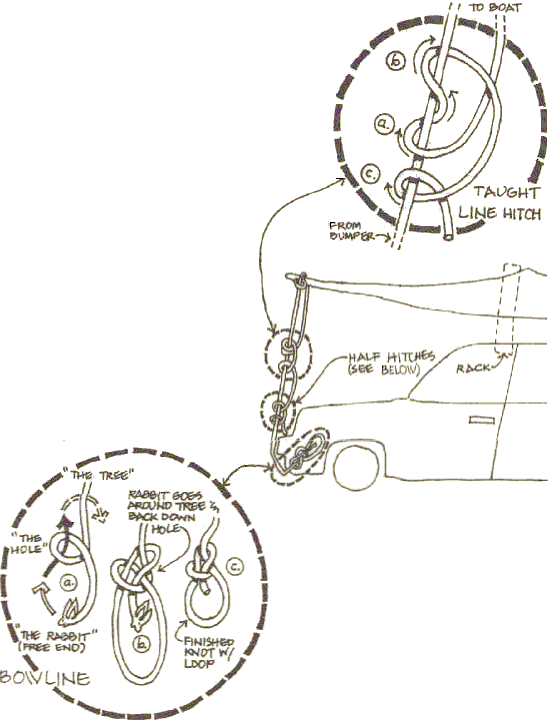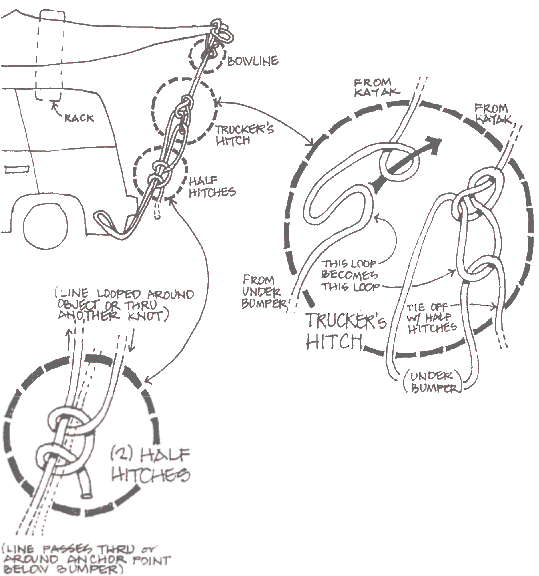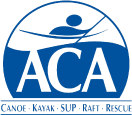by Leslie Allen. Published in Bay Currents, September 2000
There are many reports of rack failure and human error in which the conscientious kayakers bow and stern tie-down lines saved the lives of other people driving on the same road—or saved the life of the boat. Always secure your boat at both ends when transporting by vehicle, in addition to the lines or straps used to hold the boat on the rack or car roof.
Two alternative methods are shown in this handout, one on each side—either method is good. Keep this handout in your car or gear bag! have it laminated at a copy shop (or keep it in a plastic sleeve). All material original and copyrighted; permission is granted to club members to make copies for non-profit uses. See Advanced Tips, and use these suggestions at your own risk—you are responsible for selecting, using, and maintaining a safe system for your particular equipment.
Method A: "Taughtline Set-up"
Step A1
Secure you boat to your roof rack immediately after hoisting it up there--don't walk away--and have your tie down gear in reach before picking up the boat. Wait to tighten these lines until after you have the correct tension on the bow and stern lines.

- Follow Rack Looping Diagram below: Pass free end of line over boat, under crossbar on far side of boat, back over boat, and under cross bar on near side. Tie off near boat waterline. Set up knots so you pull downward to tighten. Tie down using webbing straps.
- Use nylon webbing straps with cam buckles ("cam straps"), or cradles with integral tie-down straps--always tie a half hitch over the cam buckle for extra security.
- OR use a rope with knots illustrated in this handout--try several to find a combo that works for you.
Step A2
Start under the bumper by securing tie down line (NOT recommended to be the same as your kayak bow line or painter--keep separate lines for tie downs).
- For example keep a permanent bowline knot and loop in one end of your tie down rope. Pass the free end of the rope through the towing eye under your bumper (or other structural element that doesn't have sharp, rope-fraying edges) and then through the bowline loop. See also Advanced Tips.

Step A3
Draw the rope up and pass through the steel eye or carry loop o the end of your boat, AND over the boat's bow or stern.
- Pull down gently and make a TAUGHTLINE HITCH. Increase the tension on this knot after you finish by sliding the knot (some tension is necessary while tying it).
- Take up any long loose ends of line with a series of HALF HITCHES--you can double the line if you have a lot of extra.
- Go back and tighten roof rack lines.
Method B: "Trucker's Set-up"
Step B1
Same as step A1 (secure boat).
Step B2
Start by securing your tie down line to the end of your boat. You could use the carry loop, toggle, or deck hardware, but better yet, make a loop you pass the end of your boat through AND pass the free end of the line through carry loop, etc.

Step B3
Pass the free end of the rope thru the anchor point under you bumper and let it hang loose.
- Grab the rope (not the free end) where it's hanging at shoulder height, and tie a TRUCKER'S HITCH
- (it will end up lower after you cinch it down).
- Be VERY careful tightening, and listen--you don't want to hear the cracking of you boat. (The trucker's hitch has a "mechanical advantage" like from a block and tackle rig.) This knot should be secure but not super-tight!
- Tie off line below trucker's hitch w/ HALF HITCHS.
- Go back and tighten lines securing boat to roof top or rack.
Advanced Car Top Tips
- Always walk around your whole "rig" before driving off.
- Check especially the knots someone else has tied for you, whether it's your car, or your boat on someone else's car.
- Talk with knowledgeable salespeople at a good store to make sure you aren't using or buying rope that stretches, which could result in a disaster.
- Use a flame to melt the cut ends of nylon or plastic ropes or straps to keep them from fraying.
- If you're using straps, put a twist or two in them to cut down on noise created at high speeds.
- Tuck extra strap length (folded up) between boat hull and strap.
- For cam strap buckles, keep 'em lubed, so they're easy to use, close securely, and don't rust or corrode. Try bike lube.
- Try to have all your knots where you can see them (not under your bumper, for example) in case they need attention.
- Tie straps or ropes to rack crossbar inboard of the tower, not on the outside where the line may slip off the end.
- You may find it more convenient to use a carabiner under the bumper (if you have a towing eye that will work) so you don't have to tie a knot there or pass the free end of a long line thru the eye--just slip line thru the 'biner gate.
- The Taughtline Hitch doesn't work well with some ropes, like twisted poly, so use the Trucker's Hitch instead.
- Look up online resources, such as www.netknots.com.

- Many newer cars have aerodynamic front bumpers with no place to tie a rope. You could install permanent nylon webbing loops inside your engine compartment, to be pulled out and used as tie-down anchor points. (Check first to see if your hood will close securely over a couple layers of webbing each side.) Use bolts and large washers, and be mindful of where the loops will hang inside when not in use.
- "Triangulation" is great at the front of your car if you have 2 anchor points under the bumper—it limits side-to-side sway.
Back to Technical and Gear

